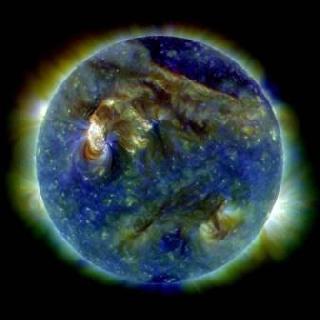
The Sun on August 1, 2010, as seen by the Atmospheric Imaging Assembly on NASA's Solar Dynamics Observatory. Photo by NASA / Lockheed Martin
PALO ALTO, CALIFORNIA (BNS): Scientists will now be able to uncover the physical mechanism behind so-called “sympathetic flares” on the Sun with data provided by new solar instruments.
For over 75 years, solar physicists have been observing near-synchronous explosions in the solar atmosphere.
On August 1st nearly the entire Earth-facing side of the Sun erupted in a tumult of activity, comprising a large solar flare, a solar tsunami, multiple filaments of magnetism lifting off the solar surface, radio bursts and half a dozen coronal mass ejections (CMEs).
At the same time, three NASA spacecraft–the Solar Dynamics Observatory (SDO) and the twin Solar Terrestrial Relations Observatory (STEREO) spacecraft–were ideally positioned to capture both the action on the Earth-facing side of the Sun, and most activity around the backside, leaving a wedge of only 30 degrees of the solar surface unobserved.
“The high-quality simultaneous data we received from SDO and the STEREO spacecraft, and our subsequent analysis, enable us to present unambiguous evidence that solar regions up to 160 degrees away are involved in defining the large-scale coronal field topology for flares and CMEs” said Dr. Carolus Schrijver, lead author of a paper presented Monday at the American Geophysical Union Winter Meeting in San Francisco.
“Moreover, as far as we are aware, this is the first well-documented case that is highly suggestive that the evolution of that distant field, i.e. the flux emergence in one or more of the three active regions behind the eastern limb of the Sun as seen from Earth and SDO, plays an important role in the destabilization of the magnetic field involved in a series of CMEs aimed for Earth.”
At the time of the August 1st observations, the STEREO spacecraft were each approaching quadrature relative to the Sun-Earth line, thus providing perspectives on activity on most of the eastern and western hemispheres relative to Sun-Earth line.
Moreover, the SDO Helioseismic and Magnetic Imager (HMI), combined with a computational model of full-sphere flux-transport on the Sun, and global coronal field modeling, revealed the long-distance magnetic connections with fair fidelity.
Dr. Alan Title of the ATC and co-author of the paper said, “We now have evidence that multiple events can be triggered by other events that occur in regions that cannot be observed from Earth orbit. This gives us a new appreciation of why solar flare and CME predictions have been less than perfect.
As we seek to understand the causes of eruptive and explosive events that will improve our ability to forecast space weather, it is clear that we must be able to analyze most of the evolving global solar field, if not all of it,” he said.
The events that took place on the Sun on August 1st propagated outward into the solar system and eventually reached Earth on August 5th and 6th.
 Previous Article
Previous Article Next Article
Next Article













The Indian Air Force, in its flight trials evaluation report submitted before the Defence Ministry l..
view articleAn insight into the Medium Multi-Role Combat Aircraft competition...
view articleSky enthusiasts can now spot the International Space Station (ISS) commanded by Indian-American astr..
view article